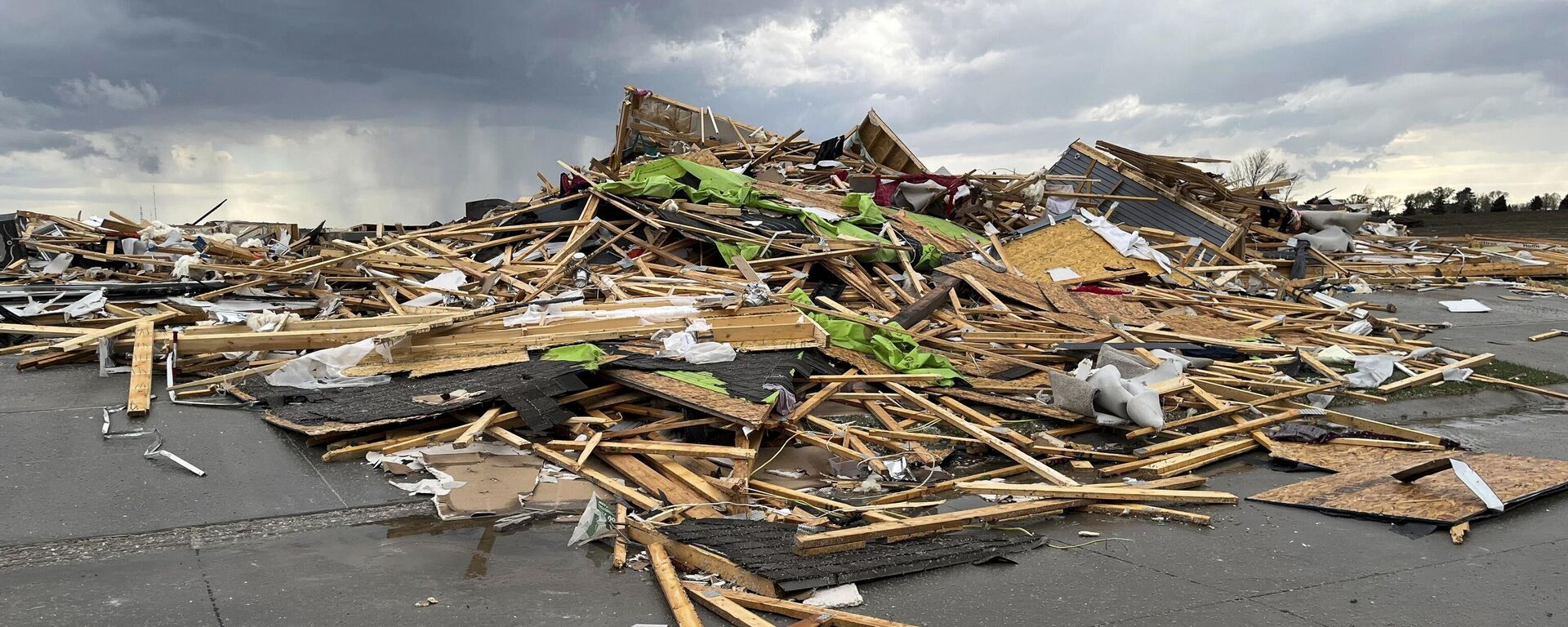https://sputnikglobe.com/20240429/us-may-be-facing-its-hottest-summer-ever-1118169104.html
US May Be Facing Its Hottest Summer Ever
US May Be Facing Its Hottest Summer Ever
Sputnik International
The Southwest, part of the Pacific Northwest, and Hawaii are some of the regions that will be most susceptible to drought this coming summer.
2024-04-29T05:05+0000
2024-04-29T05:05+0000
2024-04-29T05:05+0000
beyond politics
us
national oceanic and atmospheric administration (noaa)
weather
climate
climate change
heat wave
heatwaves
temperature
national weather service
https://cdn1.img.sputnikglobe.com/img/07e8/04/1d/1118168940_0:160:3072:1888_1920x0_80_0_0_95cbfb74b828322cdf37e71d18d83a2e.jpg
A new study released by the National Weather Service (NWS) has found that for the summer months, temperatures could be 60% above normal for the United State’s New England region as well as the Southwest. The National Oceanic and Atmospheric Administration (NOAA) and the the Centers for Disease Control and Prevention (CDC) recently rolled out tools that will focus on forecasting when extreme heat waves will hit this summer, so they may be better equipped to warn people about these events.This means that for the months of July through September, states including; Maine, New Hampshire, Vermont, Massachusetts, Connecticut, Rhode Island, Texas, New Mexico, Arizona, Colorado, Utah, Nevada, Idaho, western Wyoming and Montana, as well as eastern Oregon and Washington, could experience sweltering, record-breaking temperatures.The summer of 2023 was already Earth’s hottest season since global records first began in 1880, said scientists at NASA’s Goddard Institute of Space Studies (GISS) in New York. The months of June, July, and August combined were 0.42 degrees Fahrenheit (0.23 degrees Celsius) warmer than the average summer between 1951 and 1980.Last summer’s heat wave contributed to disastrous wildfires in Canada and Hawaii, dangerous temperatures and wildfires across Europe, and a heatwave that spanned from Thailand to Northern China that created the worst April heatwave in South China on record. And sadly, this summer may be no different.Higher summer temperatures will lead to a loss of water for flora, fauna, people and animals. The Southwest, part of the Pacific Northwest, and Hawaii are some of the regions that will be most susceptible to drought this coming summer, said the NWS. A higher frequency of lightning thanks to the warmer temperatures will be possible too, and could increase the risk of wildfires which are already at risk.This Atlantic season could also feature nearly twice as many named hurricanes than usual, with anywhere between 27 and 39 tropical storms being possible due to warmer ocean temperatures helping to create a more intense hurricane season, said a group of climate scientists from the University of Pennsylvania.The record-breaking heat will not only have an adverse effect on our environment, but may seriously impact people’s health. Those who have health issues tied to cardiovascular disease could become seriously sick or die.These hotter temperatures are being driven by climate change. William Boos, a UC Berkeley earth and planetary sciences associate professor told a US news source that the “obvious player is greenhouse gasses that are producing long-term climate change.”The La Niña weather pattern is also expected to make a return this year, and could develop as early as summer and continue into fall, according to data from the NWS. And it is possible that it could contribute to drier conditions in some parts of the US, but it’s still too early to predict those conditions.While La Niña can lead to a “cooling down of global temperatures... it causes changes in wind patterns that can cause some areas to be warmer than normal in summer,” says University of Pennsylvania climate scientist Michael Mann.La Niña is the “cold phase” of the El Niño-Southern Oscillation cycle. However, the climate phenomenon should have little influence on weather in the Northern Hemisphere over the summer months but will most likely follow through with a greater impact in the winter. And despite the predictability of the cycle, sometimes its influence on seasonal patterns is limited.
https://sputnikglobe.com/20240427/terrifying-tornadoes-rip-across-us-midwest-with-no-sign-of-easing-1118137275.html
Sputnik International
feedback@sputniknews.com
+74956456601
MIA „Rossiya Segodnya“
2024
News
en_EN
Sputnik International
feedback@sputniknews.com
+74956456601
MIA „Rossiya Segodnya“
Sputnik International
feedback@sputniknews.com
+74956456601
MIA „Rossiya Segodnya“
noaa, nws, climate, temperature, weather, heatwave, climate change, high temperature, extreme weather, extreme weather conditions
noaa, nws, climate, temperature, weather, heatwave, climate change, high temperature, extreme weather, extreme weather conditions
US May Be Facing Its Hottest Summer Ever
Serious environmental consequences could follow a dangerously hot summer, as a higher risk of drought, hurricanes and wildfires are on the horizon.
A new
study released by the National Weather Service (NWS) has found that for the summer months, temperatures could be 60% above normal for the United State’s New England region as well as the Southwest. The National Oceanic and Atmospheric Administration (NOAA) and the the Centers for Disease Control and Prevention (CDC) recently rolled out tools that will focus on forecasting when extreme heat waves will hit this summer, so they may be better equipped to warn people about these events.
This means that for the months of July through September, states including; Maine, New Hampshire, Vermont, Massachusetts, Connecticut, Rhode Island, Texas, New Mexico, Arizona, Colorado, Utah, Nevada, Idaho, western Wyoming and Montana, as well as eastern Oregon and Washington, could experience sweltering, record-breaking temperatures.
The summer of 2023 was already Earth’s hottest season since global records first began in 1880, said scientists at NASA’s Goddard Institute of Space Studies (GISS) in New York. The months of June, July, and August combined were 0.42 degrees Fahrenheit (0.23 degrees Celsius) warmer than the average summer between 1951 and 1980. Last summer’s heat wave contributed to disastrous wildfires in Canada and Hawaii, dangerous temperatures and
wildfires across Europe, and a heatwave that spanned from Thailand to Northern China that created the worst April heatwave in South China on
record. And sadly, this summer may be no different.
Higher summer temperatures will lead to a loss of water for flora, fauna, people and animals. The Southwest, part of the Pacific Northwest, and Hawaii are some of the regions that will be most susceptible to drought this coming summer, said the
NWS. A higher frequency of lightning thanks to the warmer temperatures will be possible too, and could increase the risk of wildfires which are already at risk.
“From mid-April through the end of July 2024, a line could be drawn from the Rockies and the southern High Plains to delineate the forecast,” the NWS wrote. “West of this line, drought is expected to persist or intensify where it exists, and a Long-Lead Outlook favoring below-normal May-July precipitation led to a forecast for drought development in a few areas with some degree of pre-existing dryness.”
This Atlantic season could also feature nearly twice as many named hurricanes than usual, with anywhere between 27 and 39 tropical storms being possible due to warmer ocean temperatures helping to create a more intense hurricane season, said a group of climate
scientists from the University of Pennsylvania.
The record-breaking heat will not only have an adverse effect on our environment, but may seriously impact people’s health. Those who have health issues tied to cardiovascular disease could become seriously sick or die.
These hotter temperatures are being driven by climate change. William Boos, a UC Berkeley earth and planetary sciences associate professor told a US news source that the “obvious player is greenhouse gasses that are producing long-term climate change.” The La Niña weather pattern is also expected to make a return this year, and could develop as early as summer and continue into fall, according to data from the
NWS. And it is possible that it could contribute to drier conditions in some parts of the US, but it’s still too early to predict those conditions.
While La Niña can lead to a “cooling down of global temperatures... it causes changes in wind patterns that can cause some areas to be warmer than normal in summer,” says University of Pennsylvania climate scientist Michael Mann.
La Niña is the “cold phase” of the El Niño-Southern Oscillation cycle. However, the climate phenomenon should have little influence on weather in the Northern Hemisphere over the summer months but will most likely follow through with a greater impact in the winter. And despite the predictability of the cycle, sometimes its influence on seasonal patterns is limited. 


